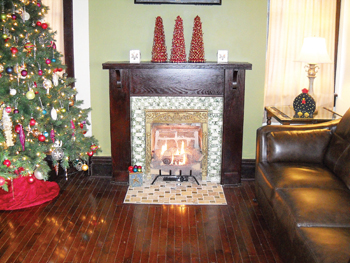Tony Eaton said he had to look through a friend's eyes to see what an incredible place Chattanooga has become.
That done, he invested in the city - although he lives part-time in Atlanta - by purchasing and renovating a 1920 home in Highland Park.
"I loathed the [Southeast Tennessee/North Georgia] area," said Eaton, who grew up in LaFayette, Ga., but often came to Chattanooga in his youth.
But years after working in Atlanta, he returned to Chattanooga with a friend, who extolled the area's beauty.
"I saw it for what it was," Eaton said.
Enticed, he found the Craftsman bungalow he would renovate after a search of five or six months. He said he "got in inexpensively" but "put a good deal [of money] into it."
Eaton, who is employed by a financial company in Atlanta, felt he could make something of the home but knew its bowed brick sides would need shoring up. It turned out the home had no exterior wood framing, so that was the first task for him and contractor Danny Yarber.
Although he liked the home's floor plan, he added on to the back, floored in the attic to make a loft and turned a sunroom into a second downstairs bathroom.
"It all came together," Eaton said. "All in all, it turned out real nice."
Since the home had four working gas fireplaces, dark wood molding, pocket doors and period lighting, he wanted to save or repurpose everything he could
when the house was taken down to its foundation.
Most of it was returned to the renovated house, even including a window frame that serves as the top of a sitting-room side table. The hardwood floors throughout could not be saved but were replaced by similar hardwood.
The home's central hallway became stairs to the loft, which was formed by adding two dormers to what Eaton said was a huge attic. A second-floor bathroom made the space amenable to a variety of uses.
The sitting room and front bedroom changed little, but the tiled sitting-room hearth had to be replaced. The new cream and brown tiles accentuate the dark hardwood floors.
The wall that separated what apparently was the dining room from the former tiny kitchen was removed except for its fireplace. That fireplace now serves both the former dining room, where Eaton has his 1929 Wissner grand piano, and the expanded kitchen.
The expansion along the rear of the house created the larger kitchen and a dining area. The kitchen features stainless-steel appliances, copper farmhouse sink, granite countertops, stained-glass window, gun rack repurposed as a kitchen cabinet and an oversize three-piece cabinet unit surrounding the gas range top.
The dining area is outfitted with table, chairs and buffet - believed to be period pieces - that originally came from a home on Lookout Mountain.
One of the downstairs bathrooms and an upstairs bath have attractive tile inlays, but the original bathroom is no less attractively outfitted.
The inside renovation took a year, Eaton said, but the outside got a facelift, too. Landscaping was installed throughout, and a brick wall and metal arch - with floral inserts - were erected at street level as was a wooden fence in back. A large deck at the back of the house is the most recent addition.
His Highland Park neighbors, he said, have been both friendly and a source of history of his house.
"It was difficult but rewarding," Eaton said of his initial renovation project. "This house is a part of me. It was a labor of love."

